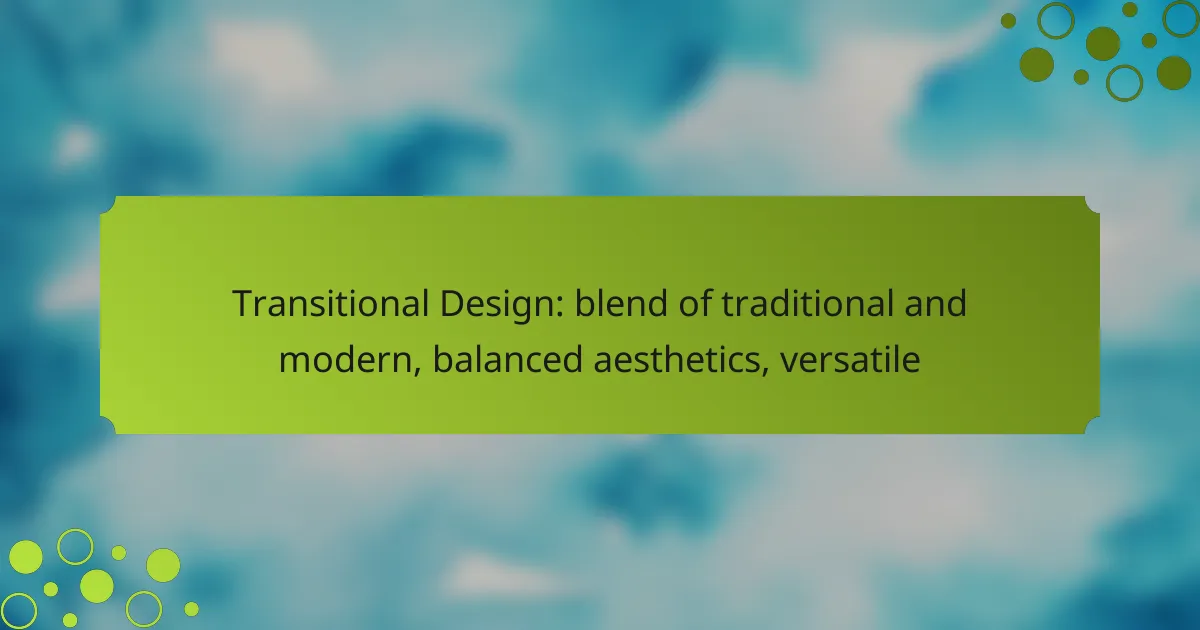Transitional design is a harmonious blend of traditional and modern aesthetics, resulting in a balanced and versatile style that appeals to diverse tastes. By incorporating classic elements alongside contemporary materials and techniques, this approach creates inviting spaces that enhance comfort and property value.

How does transitional design blend traditional and modern aesthetics?
Transitional design seamlessly merges traditional and modern aesthetics, creating a balanced and versatile style. This design approach incorporates classic elements while embracing contemporary materials and techniques, resulting in a cohesive and inviting space.
Integration of classic elements
In transitional design, classic elements such as crown molding, wainscoting, and traditional furniture styles are integrated to provide a sense of history and warmth. These features are often softened with modern touches, allowing them to feel fresh and relevant. For example, a traditional wooden dining table may be paired with sleek, contemporary chairs to create a striking contrast.
When selecting classic elements, consider their scale and proportion in relation to the overall space. Oversized traditional pieces can overwhelm a room, while smaller, more refined items can enhance the aesthetic without dominating it.
Use of contemporary materials
Contemporary materials play a crucial role in transitional design, offering a fresh take on classic styles. Materials such as glass, metal, and concrete can be used alongside traditional wood and textiles to create visual interest. For instance, a glass coffee table can provide a modern counterpoint to a vintage sofa.
When choosing materials, aim for a balance that maintains the integrity of both styles. Mixing materials should feel intentional rather than haphazard, enhancing the overall design rather than detracting from it.
Color palette balance
A balanced color palette is essential in transitional design, often featuring neutral tones complemented by bold accents. Soft grays, whites, and beiges serve as a backdrop, while deeper hues like navy or emerald can be introduced through accessories or feature walls. This approach allows for flexibility and personalization without overwhelming the space.
To achieve color balance, consider using the 60-30-10 rule: 60% of the room should be a dominant color, 30% a secondary color, and 10% an accent color. This method ensures a harmonious and visually appealing environment.
Furniture style fusion
Transitional design excels in furniture style fusion, combining pieces from different eras to create a unique look. For example, a mid-century modern chair can be paired with a traditional side table, creating a dialogue between styles. This eclectic mix allows for personal expression while maintaining a cohesive aesthetic.
When fusing furniture styles, focus on common elements such as color, material, or shape to create unity. Avoid mixing too many styles at once, as this can lead to a disjointed appearance.
Architectural harmony
Architectural harmony is vital in transitional design, ensuring that both traditional and modern elements work together cohesively. This can involve maintaining consistent lines and proportions throughout the space, as well as ensuring that architectural features like windows and doors complement the overall design. For instance, modern windows can be framed with traditional trim to create a seamless transition.
To achieve architectural harmony, consider the overall layout and flow of the space. Ensure that each element contributes to a unified design, avoiding any features that feel out of place or disconnected from the overall aesthetic.

What are the benefits of transitional design in Australian homes?
Transitional design in Australian homes combines traditional and modern elements, offering a balanced aesthetic that appeals to a wide range of tastes. This style enhances versatility, comfort, and property value, making it a popular choice for homeowners looking to create a welcoming and stylish environment.
Versatility in decor
Transitional design allows for a seamless blend of various styles, making it easy to incorporate both contemporary and classic pieces. Homeowners can mix furniture, colors, and textures without clashing, resulting in a cohesive look that reflects personal taste. For instance, pairing a modern sofa with a vintage coffee table can create a unique focal point in the living room.
This versatility extends to color palettes as well, where neutral tones can serve as a backdrop for bold accents, allowing for easy updates as trends change. It’s advisable to choose a few key elements that resonate with your style to maintain harmony throughout the space.
Timeless appeal
One of the main advantages of transitional design is its timeless appeal, which avoids the risk of becoming outdated. By combining classic elements with modern touches, this style remains relevant across different eras, making it a smart investment for homeowners. For example, a traditional fireplace can be complemented with sleek, modern furniture to create a space that feels both current and enduring.
When selecting decor, consider pieces that have stood the test of time, such as leather sofas or wooden dining tables, as they contribute to a lasting aesthetic. This approach not only enhances the beauty of your home but also ensures that it remains stylish for years to come.
Enhanced comfort
Transitional design prioritizes comfort by focusing on functional layouts and inviting materials. Soft fabrics, ergonomic furniture, and open spaces contribute to a relaxed atmosphere, making homes more enjoyable for everyday living. For instance, using plush rugs and cozy throws can create a warm and inviting environment.
When designing your space, consider how each element contributes to comfort. Opt for furniture that encourages social interaction, such as sectional sofas or round dining tables, to foster a sense of community within the home.
Increased property value
Implementing transitional design can enhance the overall value of a property, appealing to a broader range of potential buyers. Homes that feature a balanced aesthetic are often perceived as more desirable, leading to quicker sales and potentially higher offers. In Australia, properties that showcase a harmonious blend of styles tend to attract buyers looking for both modern amenities and classic charm.
To maximize property value, focus on high-quality materials and finishes that reflect the transitional style. Investing in well-crafted fixtures and maintaining a cohesive design throughout the home can significantly impact resale value, making it a worthwhile consideration for homeowners.

How to implement transitional design in your space?
To implement transitional design in your space, focus on blending traditional and modern elements to create a balanced aesthetic. This approach emphasizes versatility and comfort while maintaining a cohesive look throughout the environment.
Choose a neutral color scheme
A neutral color scheme serves as the foundation for transitional design, allowing both traditional and modern elements to shine. Opt for shades like beige, gray, and soft whites to create a calming backdrop.
Consider adding pops of color through accessories such as cushions or artwork, ensuring they complement the overall palette. This strategy helps maintain a harmonious balance without overwhelming the space.
Mix vintage and modern furniture
Combining vintage and modern furniture pieces is essential for achieving a transitional look. Look for classic items with clean lines that can coexist with contemporary designs, such as a traditional wooden dining table paired with sleek metal chairs.
When selecting furniture, aim for a mix of textures and materials to enhance visual interest. Avoid matching sets; instead, curate a collection that tells a story and reflects your personal style.
Incorporate layered textures
Layered textures add depth and warmth to transitional spaces. Use a variety of materials, such as soft fabrics, smooth woods, and metal finishes, to create a rich sensory experience.
For example, combine a plush area rug with leather sofas and woven throws. This approach not only enhances comfort but also visually ties together different design elements, making the space feel inviting.
Focus on functional layouts
Functional layouts are crucial in transitional design, ensuring that the space is both stylish and practical. Arrange furniture to promote easy movement and conversation, keeping pathways clear and accessible.
Consider the purpose of each area and how it will be used. For instance, in a living room, position seating to encourage interaction while maintaining a comfortable flow. This thoughtful arrangement enhances the overall functionality of the space.

What are the key elements of transitional design?
Transitional design is characterized by a harmonious blend of traditional and modern elements, creating a balanced aesthetic that is both timeless and versatile. Key elements include a neutral color palette and balanced proportions, which together foster a cohesive and inviting space.
Neutral color palette
A neutral color palette is essential in transitional design, as it serves as a calming backdrop that allows both traditional and modern elements to shine. Common choices include shades of beige, gray, and taupe, which can be accented with deeper hues for added interest.
When selecting colors, consider using a mix of warm and cool tones to create depth. For instance, pairing a soft gray with warm cream can enhance the room’s warmth while maintaining a sophisticated look. Avoid overly bright or saturated colors, as they can disrupt the balance typical of transitional spaces.
Balanced proportions
Balanced proportions are crucial in transitional design, ensuring that no single element overwhelms the space. This involves selecting furniture and decor that are appropriately scaled to the room, creating a sense of harmony and flow.
For example, a large sectional sofa can be balanced with a pair of smaller accent chairs, while a substantial coffee table can be complemented by lighter side tables. Aim for a mix of shapes and sizes that work together, avoiding extremes that can lead to visual clutter. Remember, the goal is to create an inviting atmosphere that feels both comfortable and stylish.
